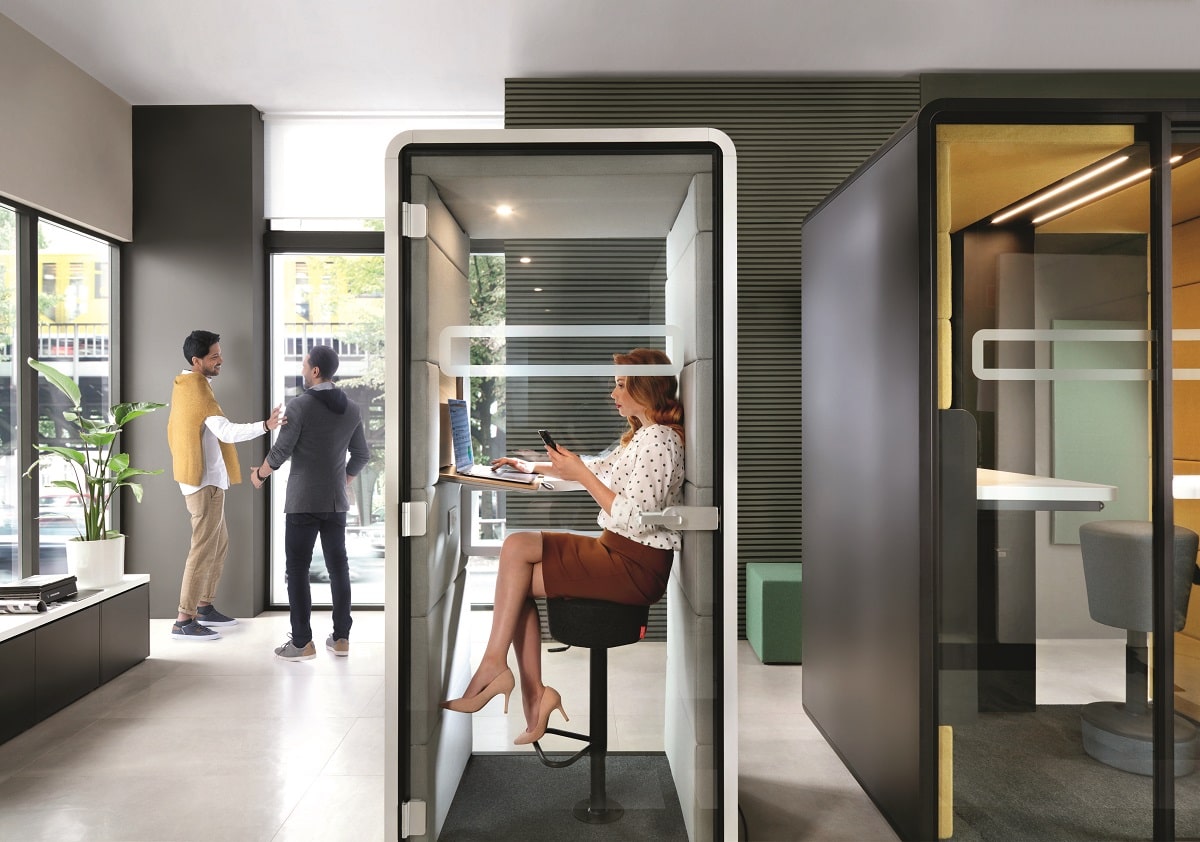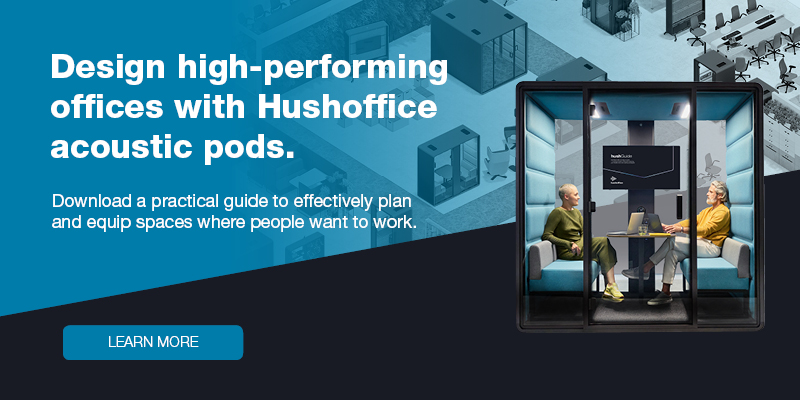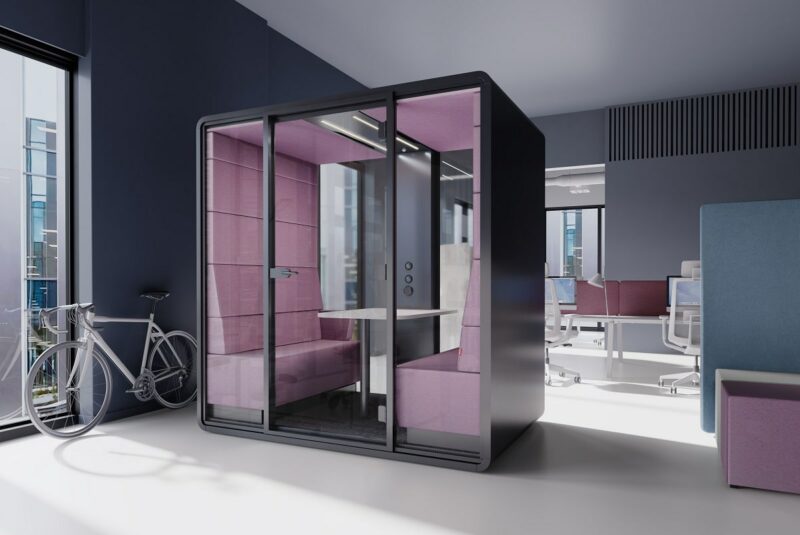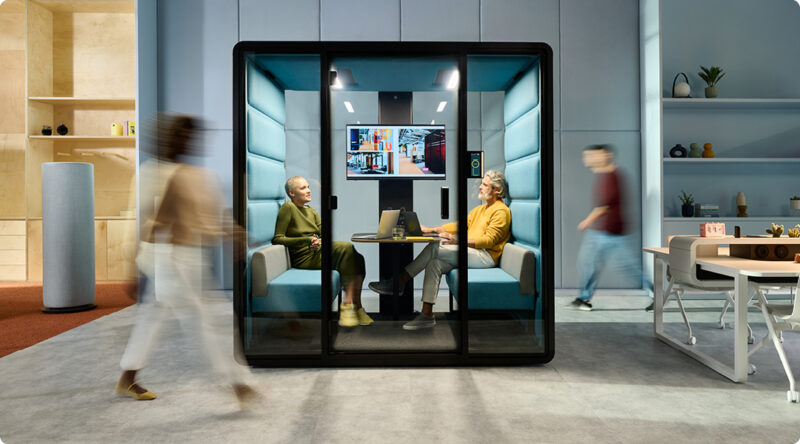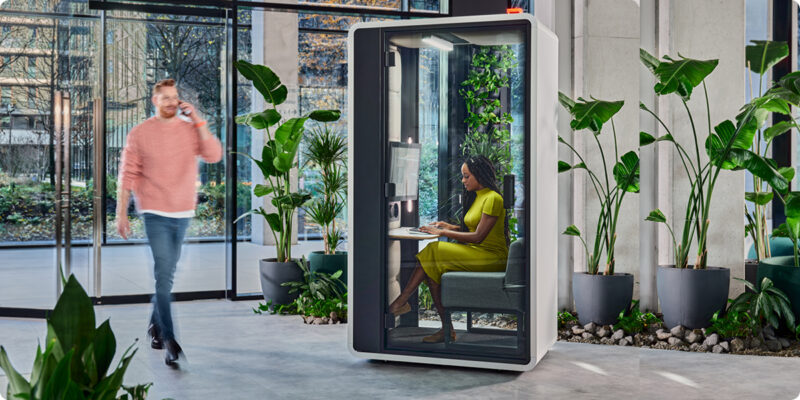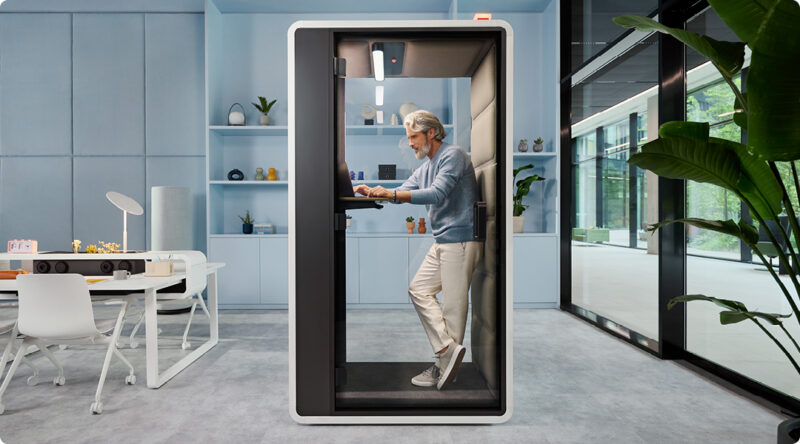The most important office design trends for 2024
- Posted on: 3 January 2024
- By: Hushoffice Team
There may be no better time than a new year to rethink the make of the space people spend nearly 20% of their life in focused effort: the office. To follow are some of the most important workplace design trends for 2024.
The most important office design trends for 2024 – tl;dr
Office pods will become standard as employee demand for privacy crystallizes.
Planners will adopt a more multisensory approach to the office’s layout. This approach will lend a variety of sensory scapes to best accommodate neurodiversity.
Broad task-environment-fit among an increasingly diverse workforce will be key. Flexible interior solutions will be the fix. Sit-stand desks and configurable furniture will thus become the norm.
86% of employees prefer to work for companies that care about the issues they do. So it will prove imperative this year that new office products “do good.” I.e., steward earth and progress social aspirations. Organizations will take the opportunity to keep such ESG promises through the office.
Conversation spaces will become more critical. They will promote connection for the whopping 94% of employees who say it is important their workplace be somewhere they belong.
Activity-based layouts will rise in popularity, with a strict emphasis on acoustic privacy.
Private spaces will become non-negotiable this year. Almost 80% of employees say their productivity depends on them.
Flexibility will continue to reign supreme, attracting (and satisfying) the best.
96% of US employees say they need flexibility to do their best work. Adjustable hours, work autonomy, and location freedom. The reality is flexibility can make a difference at every level, starting with the desk — employees with control over their setup alone have markedly higher job satisfaction.
A flexible working arrangement is a top three motivator for job-seeking employees
Nearly 2 in 3 US workers consider workplace flexibility options (like location and hours) to be most important, over competitive bonuses, paid time off, retirement plans, and healthcare options
Given the option to work remotely, almost 87% of US workers would take it
The surveys show that today’s workers want flexibility at every step of the employee journey. This delights office product manufacturers and space designers like the Hushoffice team who have been prioritizing flexibility for years. Us, we have long innovated on the wisdom that flexibility and accessibility go hand in hand. After all, flexible products and spaces are user-adjustable and, thus, inherently employee-centric. So as workplace layouts and organizational frameworks become more adaptive to suit workforce demands, so too will they become more friendly to all types of people
– says Mateusz Barczyk, Senior Brand Manager, Hushoffice.
The office must be flexible to facilitate “task-environment-fit” for a diverse workforce.
The concept describes a match between an employee’s needs and their workspace. Naturally, with a good “fit,” employees are happier with their set-up and perform better. A “fit” is even shown to produce more grit in employees, allowing focus and dedication to long-term goals despite adversity.
Many will give employees extra flexibility in the office by supplying it with more spaces.
With access to numerous sub-spaces, employees can go to the space right for each moment’s need (and their developing personal preferences). Unsurprisingly, the supply of suitable environments has the largest impact on outcomes in an activity-based workplace.
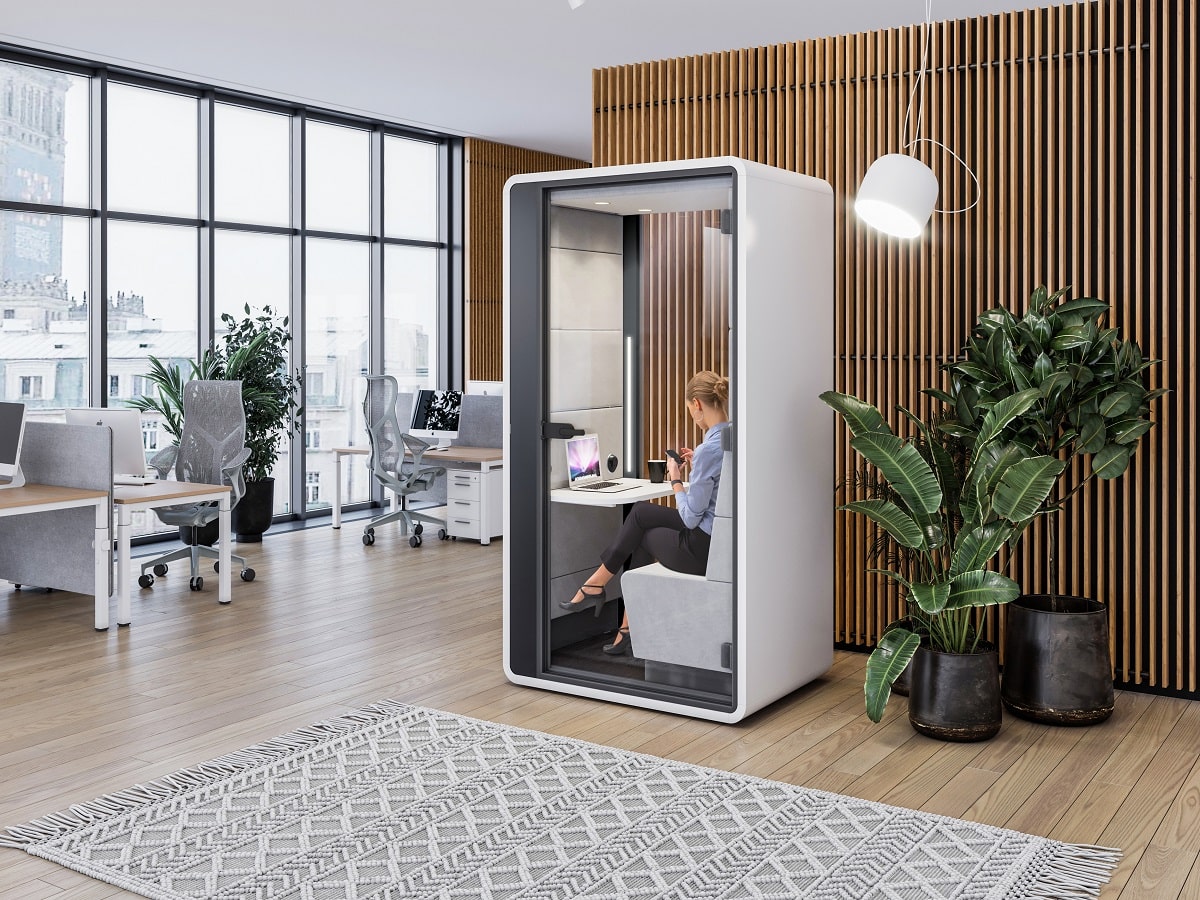
From lighting to furniture, flexibility will mark winning office products.
Workers want a mix of settings and experiences in their office. In one word: variety. The building blocks of such a space are user-controllable solutions that support many workstyles. Adjustable fans. Closeable window blinds. Sit-stand desks with leaning stools for natural perch postures. And so on.
Designing for accessibility becomes a matter of sense in 2024.
More precisely: it becomes a matter of all five senses. Neurodivergent office design entails considering the workplace through the senses. This multisensory approach will become necessarily more typical to accommodate the varied personal preferences of an increasingly diverse workforce in a systematic way.
The pursuit of universal design is an ongoing one. It can be complex and overwhelming. Many planners class individualities per cognitive abilities, age, and other demographics. But it can be helpful to appreciate that at the end of the day, regardless of differences, every person is a sensory creature, influenced by sights, sounds, and smells. Thus, a variety of sensory scapes in the office, from bustling to hushed, from bright to dim, from loud in color to subdued, is needed to cater to the inherent spectrum of employee needs, ever-changing as they are. Designing with the senses in mind like this will surely become a more common way of maximizing a workplace’s accessibility, making it work best for everyone
– says Mateusz Barczyk, Senior Brand Manager, Hushoffice.
Read more: Office design for a neurodiverse workforce
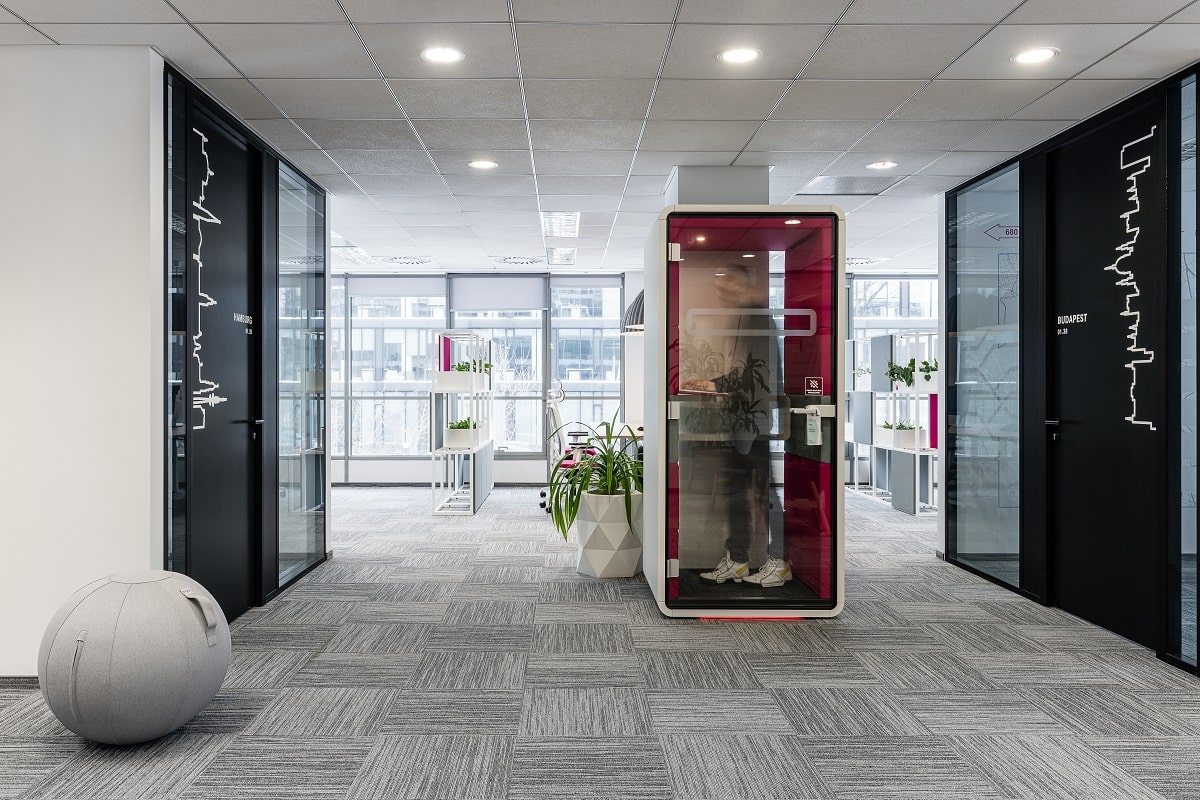
In 2024, every new product must steward earth and demonstrate ESG commitment.
83% of consumers say companies should actively shape ESG practices. 86% of employees prefer to work for companies that care about the issues they do. Perhaps this is why 91% of business leaders say their company has a responsibility to act on ESG issues.
The office can concretely realize a company’s devotion to progress.
It is one of few spaces in a digital world that can physically materialize commitments to global good. Designers can and should tap into this potential, ensuring every new furniture piece, flooring solution, or light fixture moving forward satisfies the right social and environmental metrics.
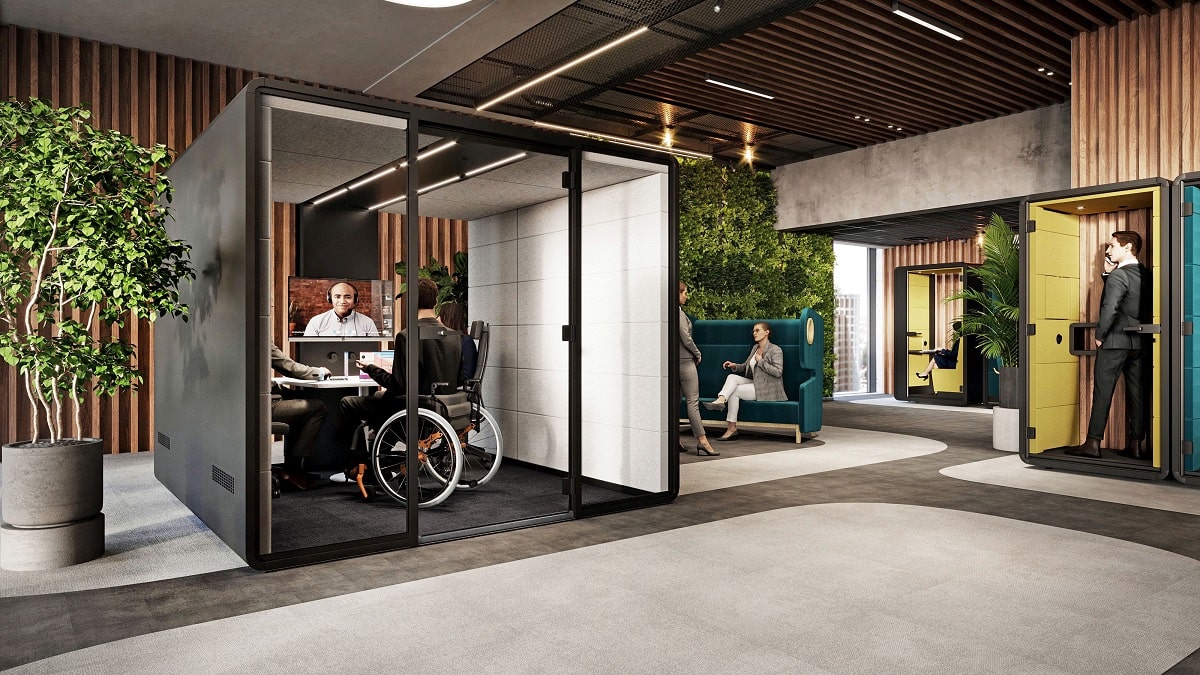
Equity and accessibility takes many forms in the world of office interiors.
Consistently, every new interior solution should afford maximum personal control, or user-adjustability, letting employees tweak and use each workspace accordingly. This is because personal control is one of the most influential factors on building occupant satisfaction.
Greater direct individual control in the workplace leads to higher thermal comfort, higher satisfaction, energy savings, and productivity at work.
The link between personal control and employee satisfaction with the office makes sound sense. We have all experienced the angst that lacking control over our immediate space can induce, making it impossible to settle into a space, whether a barrage of noise or harsh overhead lighting is to blame. On the other hand, an affordance of control gives sovereignty over one’s space, befitting focus and overall frame of mind. And when we talk about accessibility in the context of the office, what we are really talking about is the accommodation of varying needs to do with such factors as sound and lights. User-adjustable interior solutions thus short-circuit this accommodation by letting employees adapt the space exactly to their particular needs. Perhaps that means cocooning in a quiet pod like hushHybrid for unfettered concentration. Or dimming the lights for a moment of pause. The main thing is that the employee can find harmony in their workplace regardless of their individual constitution
– says Mateusz Barczyk, Senior Brand Manager, Hushoffice.
Belonging is the name of the game. Community matters more than ever in 2024.
According to APA’s 2023 Work in America workforce survey, a staggering 94% of employees say it’s somewhat or very important to them that their workplace be somewhere they feel they belong.
Conversation spaces are a simple part of the equation.
Watercooler chat can better collaboration. Its two-way flow is also linked with greater task enjoyment. Similarly, small talk boosts positive emotions and well-being. Thus, super conversation spaces are needed in today’s office for the simple back-and-forth they foster, enabling true connection.
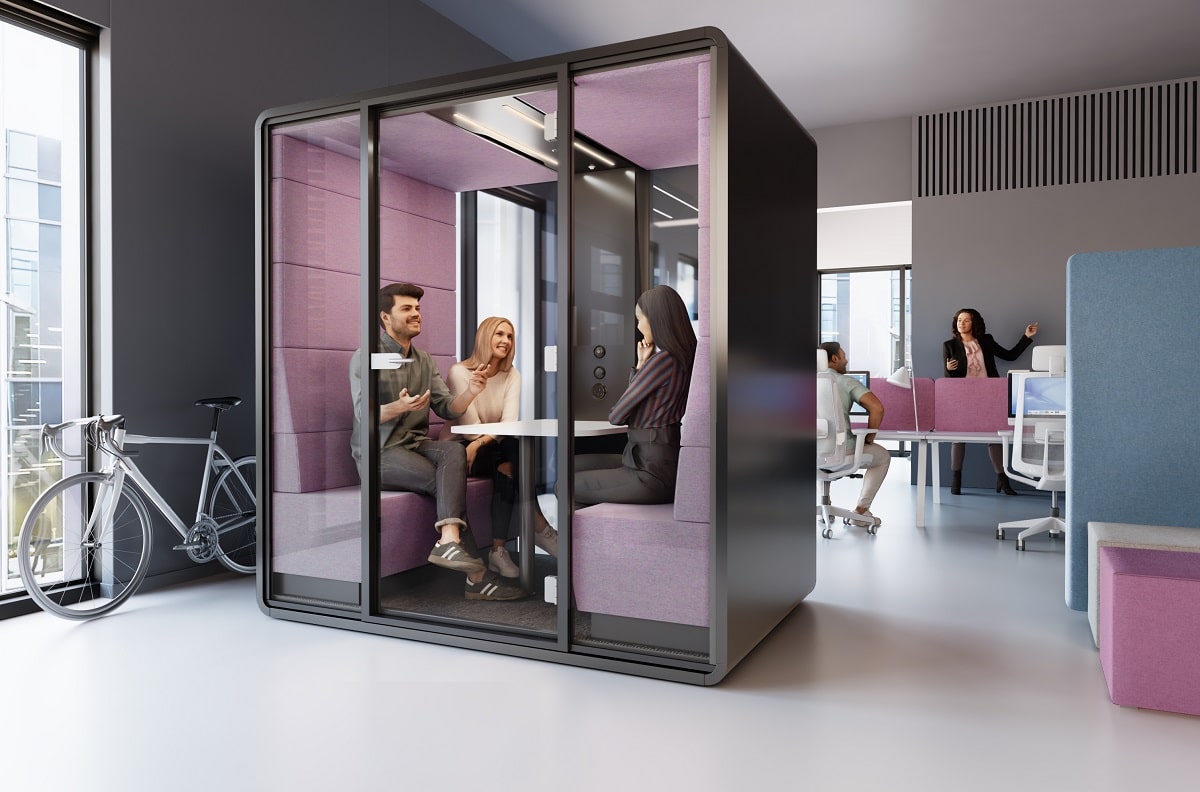
Read: How “isolation” pods make the office more social, not less
Activity-based layouts will rise in popularity, with due emphasis on acoustic privacy.
Remote working helped illuminate the office’s true purpose. More and more, employee needs are being understood through work styles and patterns over titles. Thus, ABW layouts will gain more traction this year, offering the task-oriented spaces keen to group dynamics fit for a hybrid world.
The benefits of a task-centric approach to the office’s layout, too compelling to ignore.
On average, organizations that transition to Activity Based Working see a 17% improvement in overall workplace satisfaction, a 13% increase in individual productivity, an 8% growth in team productivity, and a 4% boost in sense of community in the workplace.
Activity-based workplaces will promote the autonomy today’s employee yearns for.
As mentioned, the variety of workspaces in a well-considered activity-based office works by allowing for task-environment-fit among employees. Incidentally, this fit, in turn, increases perceived autonomy in the office, which is now one of the U.S. Surgeon General’s 5 workplace essentials.
Autonomy significantly improves productivity
Higher satisfaction, and lower work-family conflict, and turnover intentions are all related to autonomy
Employees who have autonomy report less frustration, anxiety, and doctor visits
Quiet, private spaces will become non-negotiable this year.
Almost 80% of workers say their output depends on access to focused workspaces. Being closely linked to wellness, privacy is actually a chief factor making or breaking ABW layouts. In fact, the employee’s main criteria for choosing a spot in an ABW space regards how much privacy it affords.

Privacy in the office regards the senses: visual, acoustic, personal space, and olfactory.
Office pods will become standard as employee demand for privacy crystallizes. Inside a pod, the employee is free of optical stimuli and notice by others. They are isolated from noise and protected from being overheard. And they have claim to a personal space which cannot be intruded upon.
In summary, freedom is it.
Freedom to work in the best space for the task. Freedom of mobility. Freedom of command over one’s space and guaranteed privacy during focused work. The freedom of ease as a unified team, working like a well-oiled machine. This year, the office will adapt to grant such liberties.
2024 office design trends – tl;dr
Office pods will become standard as employee demand for privacy crystallizes.
Planners will adopt a more multisensory approach to the office’s layout. This approach will lend a variety of sensory scapes to best accommodate neurodiversity.
Broad task-environment-fit among an increasingly diverse workforce will be key. Flexible interior solutions will be the fix. Sit-stand desks and configurable furniture will thus become the norm.
86% of employees prefer to work for companies that care about the issues they do. So it will prove imperative this year that new office products “do good.” I.e., steward earth and progress social aspirations. Organizations will take the opportunity to keep such ESG promises through the office.
Conversation spaces will become more critical. They will promote connection for the whopping 94% of employees who say it is important their workplace be somewhere they belong.
Activity-based layouts will rise in popularity, with a strict emphasis on acoustic privacy.
Private spaces will become non-negotiable this year. Almost 80% of employees say their productivity depends on them.
Office design trends for 2024 – frequently asked questions
What are the most important office design trends for 2024?
Flexible interior solutions including furniture. User-adjustable features like lighting and ventilation which afford personal control. Activity-based layouts. Private spaces such as Hushoffice pods.
Does ESG matter to employees?
86% of employees say they prefer to work for organizations that care about the issues they do.
What is task-environment-fit?
Task-environment-fit is the fit between an employee’s work environment and their task requirements. With a good “fit,” the employee is happier with their set-up and performs better. In an activity-based office, the trick to ensuring this fit is rather obvious: supplying the office with a rich variety of workspaces for to pick from.
